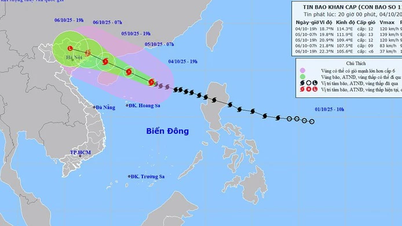World market
In the commodity market, prices of energy and materials decreased slightly compared to the previous month. This is a favorable condition to stabilize inflation globally and an important basis for many economies to implement loose financial and monetary policies to support economic recovery and development.
Recently, the IMF commented that the world seems to have almost won the war against inflation and is getting closer to countries' targets, although price pressures still exist in some countries.
The IMF expects global inflation to slow to 5.8% in 2024, down from its July forecast of 5.9%. By the end of 2025, inflation will be 3.5%.
However, risks remain, including rising commodity prices due to conflicts in the Middle East and growing trade protectionism in many countries. In addition, inflation in the service sector is still accelerating, almost double the level before the Covid-19 pandemic.
The organization forecasts global economic growth of 3.2% this year, the same level as it forecast in July. US growth is forecast to rise to 2.8%, from 2.6% previously. In contrast, GDP in the Eurozone countries may increase by only 0.8%, down 0.1% compared to the forecast three months ago.
For the emerging economies, the IMF lowered its forecast for China's economic growth from 5% to 4.8%, despite a series of new stimulus policies being introduced by the country. In contrast, India is expected to grow by 7%.
+ Fuel group
Oil prices continued to fall on overwhelming selling pressure in the market. Easing concerns about the risk of oil supply disruption in the Middle East and the prospect of weakening oil demand were the main factors putting pressure on oil prices.
Oil prices fell to their lowest level since mid-September 2024. WTI crude oil prices fell to just over $67/barrel, while Brent crude oil fell to around $71/barrel.
According to Citigroup's forecast, Brent oil prices will only fluctuate between 60 and 65 USD/barrel in 2025 due to uncertainty about the global economic outlook.
However, oil prices are still supported by escalating military tensions in the Middle East and the possibility that OPEC+ may delay increasing oil production scheduled to meet on December 1.
+ Metal group
Iron ore prices benefited from positive short-term demand as China released positive economic data, thereby strengthening the consumption outlook.
In contrast, the price of precious metals such as gold bullion, considered a hedge against political and economic instability, has at times reached nearly $2,800/oz, up more than 36% over the past year.
Gold prices have broken many record highs as the tension surrounding the US presidential election, escalating conflicts in the Middle East and expectations of the next Fed rate cut have created a perfect storm for gold. Therefore, gold prices are expected to remain high in the near future.
+ Agricultural products group
In the agricultural commodity market, prices of most types of products are down due to the prospect of abundant supply and slowing export activities.
Net exports of both old and new-crop corn totaled nearly 4.2 million tons in the week ending October 17, exceeding forecasts and marking the highest weekly export volume since May 2021, according to new data from the U.S. Department of Agriculture. Meanwhile, net exports of both old and new-crop soybeans reached an eight-week high of more than 2.1 million tons.
Notably, competitive pressure from Russian wheat supplies continues to weigh on the market.
Analysts said prices remained under control partly due to ample global supplies and uncertainty over future trade relations between the US and key markets following the US presidential election.
For rice, export prices in the Asian market have fallen the most in more than 15 months because India removed rice export tax.
Domestic market
In the context of the world economic recovery being uneven and fraught with risks and instability, the domestic socio-economic situation continues to maintain a positive trend, creating momentum for growth in the final months of the year.
Accordingly, the Vietnam Manufacturing Purchasing Managers' Index (PMI) in October 2024 is estimated to increase to over 51 points, a sharp increase compared to 47.3 points in the previous September. Consumer goods and services prices are stable at a low level, goods supply is abundant, purchasing power continues to recover, but at a slow pace .
Notably, the consumer price index is under control and there is still a large room for inflation control in 2024 according to the National Assembly's target. The average CPI for the whole year is forecasted not to exceed 4% due to many factors that reduce pressure on the price level such as:
- Cooling down global inflation helps Vietnam reduce pressure from imported inflation channels, while improving psychological factors and expectations, supporting inflation control.
- A number of tax support policies continue to be implemented such as support for reducing environmental tax on gasoline and oil, reducing value added tax, contributing to reducing costs of forming prices of goods and services...
- Food supply is still quite abundant.
- A major factor is that demand is still quite weak, consumers are still cautious in spending.
On the contrary, there are still some factors putting pressure on price levels in the remaining months of 2024 such as:
- Electricity prices, education service prices, medical examination and treatment service prices can be adjusted to increase according to the roadmap.
- Steel and cement prices increased due to increased input material prices.
- Prices of raw materials, goods and essential consumer services may increase slightly during the year-end holidays.
Based on the synthesis and analysis of related factors, the Center for Industry and Trade Information forecasts that the CPI in November 2024 may increase by about 0.1 - 0.15% compared to the previous month.
Source: https://moit.gov.vn/tin-tuc/thi-truong-trong-nuoc/du-bao-cpi-thang-11-2024-tang-0-15-.html


![[Photo] Solemn opening of the 8th Congress of the Central Public Security Party Committee, term 2025-2030](https://vphoto.vietnam.vn/thumb/1200x675/vietnam/resource/IMAGE/2025/10/4/f3b00fb779f44979809441a4dac5c7df)



![[Photo] General Secretary To Lam attends the 8th Congress of the Central Public Security Party Committee](https://vphoto.vietnam.vn/thumb/1200x675/vietnam/resource/IMAGE/2025/10/4/79fadf490f674dc483794f2d955f6045)
![[Photo] Bustling Mid-Autumn Festival at the Museum of Ethnology](https://vphoto.vietnam.vn/thumb/1200x675/vietnam/resource/IMAGE/2025/10/4/da8d5927734d4ca58e3eced14bc435a3)




















































![[VIDEO] Summary of Petrovietnam's 50th Anniversary Ceremony](https://vphoto.vietnam.vn/thumb/402x226/vietnam/resource/IMAGE/2025/10/4/abe133bdb8114793a16d4fe3e5bd0f12)

![[VIDEO] GENERAL SECRETARY TO LAM AWARDS PETROVIETNAM 8 GOLDEN WORDS: "PIONEER - EXCELLENT - SUSTAINABLE - GLOBAL"](https://vphoto.vietnam.vn/thumb/402x226/vietnam/resource/IMAGE/2025/7/23/c2fdb48863e846cfa9fb8e6ea9cf44e7)

























Comment (0)